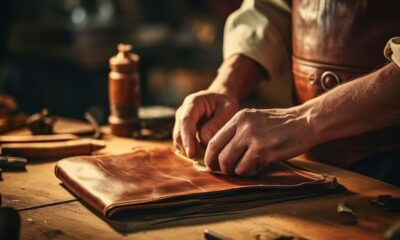In recent years, sustainability has become more than just a buzzword; it’s a movement reshaping industries around the globe. From fashion to technology, companies and consumers alike are looking for ways to minimize their environmental footprint. One of the most fascinating intersections of tradition and sustainability is the rise of “leatheling,” a term that refers to the practice of creating high-quality, eco-friendly leather goods.
In this comprehensive guide, we’ll explore the concept of leatheling, its role in promoting sustainable fashion, and how it’s influencing modern leather craftsmanship. Whether you’re a consumer looking to make more responsible choices or a designer aiming to innovate, this article will provide insights into the world of leatheling and how it’s changing the game for leather artisans worldwide.
What is Leathe ling?
Leatheling is the art of crafting leather products in a way that emphasizes sustainability, ethical sourcing, and minimal environmental impact. Traditional leather production often involves harmful chemicals, excessive water usage, and inhumane treatment of animals. However, leatheling is all about transforming this ancient craft into a modern, responsible practice.
At its core, leatheling involves:
- Using eco-friendly tanning methods: Rather than relying on harmful chemicals like chromium, which is commonly used in conventional tanning, leatheling focuses on vegetable tanning or other natural alternatives.
- Ethically sourcing hides: In the practice of leatheling, leather is often sourced as a byproduct of the food industry, ensuring that no animals are raised or harmed specifically for their skins.
- Reducing waste: Leatheling artisans aim to minimize waste by using every part of the hide and repurposing scraps into smaller items like wallets, keychains, or accessories.
- Crafting long-lasting products: By focusing on durability and craftsmanship, leatheling promotes a “buy less, buy better” approach, encouraging consumers to invest in pieces that will last for years.
The History of Leather Craftsmanship and Its Modern Revival
Leather crafting is one of the oldest artisanal practices, with evidence of leather goods dating back thousands of years. Ancient civilizations used leather for clothing, footwear, armor, and tools due to its durability and versatility. However, as industrialization took over, traditional leatherworking techniques were often replaced by mass production methods that prioritized quantity over quality.
Now, with a renewed interest in sustainability, craftsmanship, and slow fashion, the art of leatherworking—particularly through the lens of leatheling—is experiencing a revival. Many consumers are turning away from fast fashion in favor of products that are not only beautiful and functional but also responsibly made.
The Leathe Process: A Step-by-Step Look
To understand the significance of leatheling, it’s important to break down the process and see how it differs from conventional leather production. Here’s a step-by-step look at how leatheling artisans create eco-friendly leather goods:
1. Ethical Sourcing of Hides
The first step in leatheling is sourcing hides ethically. This often means using hides that are byproducts of the meat industry, ensuring that no animals are killed solely for their skins. Many leatheling brands also prioritize sourcing from local farms, which helps reduce the carbon footprint associated with transporting materials over long distances.
2. Eco-Friendly Tanning
Traditional tanning methods often involve harmful chemicals, including chromium, which can leach into water supplies and pose risks to both workers and the environment. In contrast, leatheling uses vegetable tanning or other natural tanning methods. Vegetable tanning relies on tannins from plants, such as tree bark, which are much safer and more environmentally friendly.
Although vegetable tanning takes longer than chemical tanning, the result is a more durable, natural-looking leather that ages beautifully over time. This process also ensures that the leather remains biodegradable at the end of its lifecycle.
3. Handcrafting and Design
Once the leather has been tanned, the crafting process begins. Leatheling artisans often handcraft their products, which ensures a high level of quality and attention to detail. This also allows for smaller production runs, which reduces waste and prevents overproduction—an issue that plagues many fast fashion brands.
By creating products that are designed to last, leatheling emphasizes the importance of slow fashion. Instead of churning out new collections every season, many leathesling brands focus on timeless designs that never go out of style.
4. Minimizing Waste
One of the hallmarks of leatheling is the commitment to minimizing waste. Scraps of leather that would otherwise be discarded are repurposed into smaller items, such as keychains, belts, or coin purses. This zero-waste approach is not only environmentally responsible but also allows artisans to get creative with their designs.
5. Finishing Touches and Care
The final step in the leatheling process is adding the finishing touches to the product. This might involve hand stitching, embossing, or adding hardware like buckles or zippers. Many leathesling brands also provide care instructions to ensure that their products last as long as possible. Proper care can greatly extend the lifespan of a leather item, making it an even more sustainable choice in the long run.
The Environmental Impact of Traditional Leather vs. Leathe ling
To fully appreciate the benefits of leatheling, it’s important to understand the environmental impact of traditional leather production. Here’s a side-by-side comparison:
| Aspect | Traditional Leather | Leatheling |
| Tanning Process | Uses toxic chemicals like chromium | Relies on natural, vegetable-based tanning |
| Water Usage | High, with potential for water pollution | Reduced water consumption and safer disposal |
| Waste | Often leads to significant material waste | Focus on minimizing waste and repurposing scraps |
| Ethical Sourcing | Hides may come from animals raised for skin | Hides are byproducts of the food industry |
| Product Lifespan | Shorter due to lower-quality craftsmanship | Longer, with a focus on durability |
As you can see, the differences are stark. While traditional leather production has a significant environmental footprint, leatheling offers a much more sustainable alternative.
Why Consumers are Choosing Leatheling
The shift towards leatheling is being driven by conscious consumers who are looking for alternatives to fast fashion and mass production. Here are some of the key reasons why consumers are choosing leatheling products:
1. Sustainability
As awareness about climate change and environmental degradation grows, more people are looking for ways to reduce their impact. Leatheling offers a sustainable alternative to conventional leather production by using eco-friendly methods and reducing waste.
2. Quality and Durability
In an age of disposable fashion, the idea of investing in high-quality, durable goods is becoming increasingly appealing. Leatheling products are built to last, which means consumers can enjoy them for years—if not decades—rather than having to replace them after a season or two.
3. Ethical Values
Many consumers are also drawn to leatheling because it aligns with their ethical values. By choosing brands that prioritize ethical sourcing and responsible production practices, shoppers can feel good about where their money is going.
4. Unique, Handcrafted Products
In a world of mass-produced goods, there’s something special about owning a handcrafted item. Each leatheling product is unique, with its own character and imperfections, making it a one-of-a-kind piece that reflects the artistry and skill of the maker.
The Future of Leathe: Trends to Watch
As leatheling continues to grow in popularity, several trends are emerging that could shape the future of the industry. Here are a few to keep an eye on:
1. Innovative Materials
While leatheling currently focuses on sustainable leather, the future may bring even more innovative materials into play. For example, bio-based leathers made from mushrooms, pineapple leaves, or other plant-based materials could provide even more eco-friendly alternatives.
2. Circular Fashion
The concept of circular fashion—where products are designed to be reused, repaired, and recycled—is gaining traction in the fashion world. Leatheling is well-suited to this model, as the high-quality materials and craftsmanship involved in its production make products easier to repair and recycle.
3. Technology Integration
As technology continues to evolve, we may see new tools and techniques being used to enhance the leatheling process. From 3D printing to laser cutting, these innovations could help reduce waste even further and streamline production processes.
How to Incorporate Leatheling into Your Lifestyle
If you’re interested in supporting sustainable fashion and embracing leatheling, here are a few simple ways to get started:
- Buy fewer, better products: Instead of purchasing cheap, mass-produced items, invest in high-quality leatheling products that will last for years. Look for timeless designs that won’t go out of style.
- Care for your leather: Properly caring for your leatheling items will extend their lifespan, making them even more sustainable. Follow the care instructions provided by the artisan or brand.
- Support ethical brands: Do your research and support brands that prioritize sustainability, ethical sourcing, and responsible production practices. Look for certifications like the Leather Working Group or B Corp to ensure that the brand aligns with your values.
- Recycle or repurpose old leather goods: If you have old leather items that are no longer usable, consider recycling or repurposing them. Many leathesling brands offer repair services, or you can get creative and turn them into something new.
Conclusion:
Leathe ling represents a return to thoughtful craftsmanship, where quality, sustainability, and ethics take center stage. In a world that’s becoming increasingly fast-paced and disposable, it’s refreshing to see a movement that emphasizes the importance of slowing down, creating with care, and investing in products that last.
As consumers become more conscious of their environmental impact, the demand for sustainable alternatives like leather will continue to grow. By supporting this movement, you’re not only investing in high-quality, beautifully crafted products—you’re also contributing to a more sustainable and ethical future.

